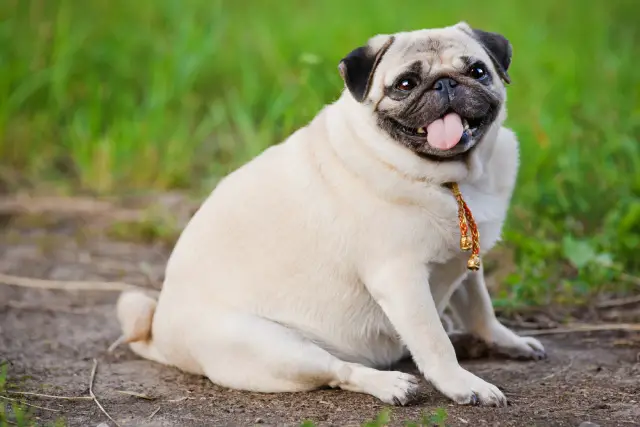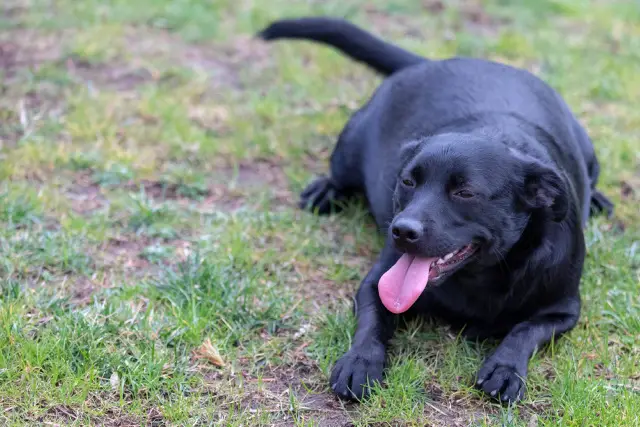Your dog has a rather voracious appetite if you do say so yourself. You try to satiate them, but if your pup or dog isn’t happy with the amount they’re being fed, they give you sad puppy-dog eyes until you refill their food bowl. You worry you might be overfeeding them, but how do you know?
Here are some signs you’re overfeeding your dog:
- Weight gain
- Bowel movement changes
- Lack of energy
- Itchiness and other skin disorders
- Frequent shedding
If you’re debating whether your dog is eating too much or just enough, this article is for you. Ahead, we’ll unpack your dog’s hungry ways and why they are the way they are and expound further on the signs that your dog is overweight and how much it should be eating.
Let’s begin!

Is Your Dog Hungry or Do They Just Like Food?
It’s a common misconception that only human beings are capable of enjoying food.
Your four-legged friend can also do the same, with a tasting infrastructure that’s similar enough to a person’s. That’s why your dog might prefer certain flavors, brands, or types of food over others.
One thing that dogs can’t do compared to us people is verbally express whether they’re hungry or just in the mood to eat. How do you know if your dog is really hungry?
You should feed a dog once or twice per day unless your veterinarian has told you otherwise. If your dog hasn’t had their first feeding yet or only one of the two feedings, it’s likely they’re hungry.
Dogs also possess a sense of time, so they know roughly when they’re supposed to be fed in both the morning and the evening.
If that’s when your dog begins whining and begging, then again, it’s likely they’re hungry.
It’s when your dog begins begging for food at other times of the day that it’s probably just them looking for an edible handout.
That’s especially the case if this behavior ramps up around family mealtimes such as breakfast, lunch, or dinner.
Things That Affect a Dog’s Food Consumption
There’s usually not one factor that influences the way your dog eats (as well as how much), but several. Let’s go over them now.
Size
A larger dog always needs to eat more than a smaller dog does, as the bigger dog needs more calories to sustain them.

This doesn’t mean a large dog is always in the mood to eat to that same level, especially if something is wrong with their health (more on this to come), but they should be eating a significant quantity of food day in and day out.
Age
It’s not necessarily a dog’s age that slows down their eating habits, but their metabolism.
Puppy has ultra-high metabolism levels so they’re burning off the food they eat very soon after consumption, leaving them ready for their next meal shortly. That’s why you feed a young puppy so much.
This very high metabolism tapers off as the dog reaches adulthood and stays at a moderate pace throughout much of the dog’s life.
As your dog reaches their senior years, its metabolism slows even further. Your dog won’t have to eat as much as it did in adulthood since they’re not burning calories to the same extent anymore.
Energy Levels
How energetic is your dog? The more playful they are, the more they expend their energy, so the more your dog will have to eat.
This is another reason why puppies are seemingly non-stop eating machines, but your dog eating more after a long walk can continue even into their adult years.
Health
A dog’s health plays a huge role in its appetite.
If your dog has intestinal parasites or some diseases, their appetite can taper off completely. That can also be the case if they’re ill or injured.
Certain medications might make your dog less hungry as well.
Food Nutritional Value
What is in your dog’s food?
If you’re giving them a balanced diet full of fats, carbohydrates, protein, and fiber, then your dog should feel full when they eat until their next mealtime or thereabouts. They might snack on treats or kibble in the interim, but not excessively.
Should the food you offer your dog be full of preservatives, additives, and other empty calories, then your dog can gobble it all up but still want more. They’re not getting enough of the nutrients and minerals they need for a healthy life.
Access to Junk Food
Almost any dog would rather eat human food than dog food.
If your pup receives table scraps with every meal you enjoy, then, of course, they’re not going to touch their food dish.
It’s not only that they’d rather eat people’s food. This food takes longer for them to process, assuming their bodies can process the food at all!
This also contributes to how long the dog’s food bowl goes untouched.
5 Signs Your Dog Is Being Overfed (Puppies and Adults)
How do you know if your dog is being overfed? Per the intro, here are five ways to be sure.
They’re Overweight
No matter your dog’s breed, there’s a general weight expectation for that breed that’s usually expressed as a range (i.e., 30 to 60 pounds).
If your dog exceeds the upper limit of that weight range, then they’ve officially entered the overweight territory.
Okay, but how can you guess if your dog is overweight? You don’t exactly have a veterinary scale.
That’s true, you don’t. You should bring them into the vet’s office to confirm, but in the meantime, you can use a reliable test.
Feel around for your dog’s ribs. Can you find them?
If yes, then your dog is likely within the normal weight range. However, if you answered no, then your dog is very likely overweight.
They’re Experiencing Bowel Movement Changes
You know how often your dog goes and what kind of consistency their fecal matter has, as you’re a good dog owner.
You’ll be the first to notice any bowel movement changes. These changes are a surefire sign your dog is eating too much.
Overfeeding might make your dog more prone to diarrhea or, at the very least, loose stools.
The reason? Your dog’s digestive system becomes overloaded to the point where it can’t absorb the nutrients it needs to quite the same degree as it once did. Thus, the food gets expelled.
If your dog has a sensitive stomach, then it might have diarrhea associated with overeating. That’s also true of puppies, but adults and seniors can experience this as well.
Your dog’s bowel movements can change in that they become less frequent as well. If your pup voraciously gobbles down every bite of food or eats too much, it could vomit.
Once they vomit, there’s not as much food in their system for them to process, which can reduce the size and frequency of their bowel movements.
That said, both vomiting and diarrhea at once can happen!
They Lack Energy
If food equals energy, then to you, it makes no sense why a dog that eats a lot would become lazy, but that’s very often the case anyway.
Your dog is overfull. They also can’t move like they once did since they’re heaving more weight around, so they’re very lethargic. Ironically, the only thing that seems to get them up and off their feet is the promise of food.
They’re Very Itchy and Have Skin Disorders
A dog that eats too much might suffer from unhealthy skin and the myriad of issues that can bring.
Your pup can begin itching more often. They could have skin infections, especially if they develop skin folds. The infections will be around the parts of the skin that fold.
Another reason your dog could develop skin infections is that they cannot reach their body anymore to groom.
They Shed More Than They Should
Between the unhealthy skin and coat and the itchiness, it should come as no surprise that an overweight, overeating dog is going to begin shedding more than its breed standard recommends.

How Much Should Your Dog Eat?
Establishing healthy eating habits early in your dog’s life needn’t be difficult.
Here’s how much a puppy should eat according to its weight and age.
| Dog Weight | Food Quantity at 6 to 12 Weeks Old | Food Quantity at 3 to 4 Months Old | Food Quantity at 5 to 7 Months Old | Food Quantity at 8 to 12 Months old |
| 3 to 5 pounds | 1 to 1 1/3 cup | ¾ to 1 cup | ½ to ¾ cup | ½ to ¾ cup |
| 5 to 10 pounds | 1 1/3 to 2 ½ cups | 1 to 2 cups | ¾ to 1 ½ cups | 2/3 to 1 cup |
| 10 to 20 pounds | 2 ½ to 4 cups | 2 to 3 ½ cups | 1 ½ to 2 2/3 cups | 1 to 2 cups |
| 20 to 30 pounds | 4 to 5 ¾ cups | 3 1/3 to 4 ½ cups | 2 2/3 to 3 2/3 cups | 2 to 2 ¾ cups |
| 30 to 40 pounds | 5 ¾ to 7 cups | 4 ½ to 5 2/3 cups | 3 2/3 to 4 ½ cups | 2 ¾ to 3 1/3 cups |
Once your dog hits adulthood, you should still use its size as a guideline for how much to feed them as this chart shows.
| Dog Weight | Dry Food Amount |
| 3 to 12 pounds | 1/3 to 1 cup |
| 13 to 20 pounds | 1 to 1/3 cup |
| 21 to 35 pounds | 1 1/3 to 2 cups |
| 26 to 50 pounds | 2 to 2 2/3 cups |
| 51 to 75 pounds | 2 2/3 to 3 1/3 cups |
| 76 to 100 pounds | 3 1/3 to 4 ¼ cups |
| 100+ pounds | 4 ¼ cups and ¼ cup per 10 pounds of body weight |
The Long-Term Effects of Feeding Your Dog
Is feeding your dog too much really so bad? If it’s very occasionally, such as on their birthday or a holiday, then no.
Making a regular habit of overfeeding can cause many detrimental effects on your dog, so let’s talk about them.
Obesity
An obese dog weighs even more than an overweight dog and has even less quality of life.
Their joints might not be able to support them, so your dog spends most of its time laying and lounging around.
They can’t play and they can’t go on long walks, which makes exercising them for weight loss difficult.
VCA Animal Hospitals notes that obese dogs are also likelier to have urinary bladder stones, osteoarthritis, and greater cancer risk, not to mention they’re likelier to develop hypertension and heart disease.
Arthritis
Canine arthritis has many causes, but obesity is the one we’ll focus on.
As we made clear in the paragraphs above, the more weight that your dog has to carry, the harder it is on its joints.
Your dog might begin walking stiffly, going lame in some limbs, and yelping in pain if you get too close to their legs.
Diabetes
It’s not necessarily that overweight dogs develop diabetes more so than dogs of lesser weight.
Instead, overweight dogs are likelier to end up being diagnosed with secondary conditions that in turn can increase their diabetes risk.
If you notice that your dog urinates a lot, drinks water far more than they did, and has cloudy eyes, then they may have canine diabetes, notes the American Kennel Club.
Gastric Dilatation Volvulus
A twisted stomach or gastric dilatation volvulus causes a dog’s stomach to rotate and stretch beyond a normal degree from a buildup of gas. According to the American College of Veterinary Surgeons, can quickly turn life-threatening.
Although dogs of any weight can develop a twisted stomach, overweight or obese dogs that eat very quickly are more at risk.
Heart Disease
An overweight or obese dog is at a greater risk of potentially deadly heart disease as well.
If you spot abdominal swelling and your dog seems very weak and even paralyzed, it could be experiencing heart disease.
Putting it all together, your dog is going to have a much shorter life when they’re overweight or obese.
Conclusion
Overfeeding your dog might make them happy at the moment, but you’re causing damaging long-term consequences such as obesity, joint issues, and possibly even heart disease.
Set them up for a healthy life by feeding them the right amount of food from their puppy years!
Related Reading:
- 11+ Homemade Dog Treat Recipes Your Dog Will Love
- How Big Will An Aussiedoodle Get (Size and Weight)
- Is Rice OK for Dogs to Eat? | Pros and Cons of Rice
- Why Puppy Is Digging at the Water Bowl (And How to Stop It)
- How Much to Feed Your Cavapoo (Puppies and Adults)
- Signs You’re Underfeeding Your Puppy
